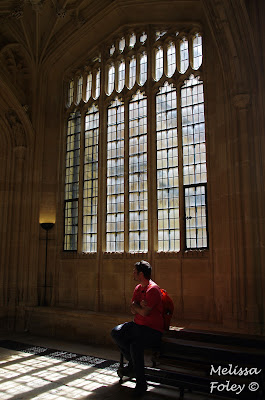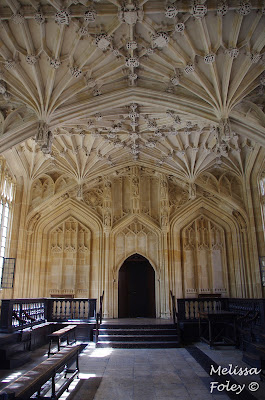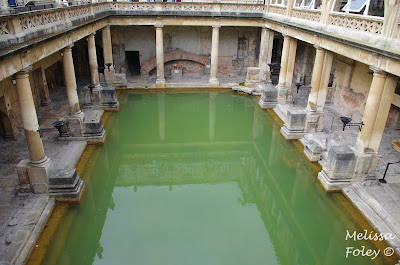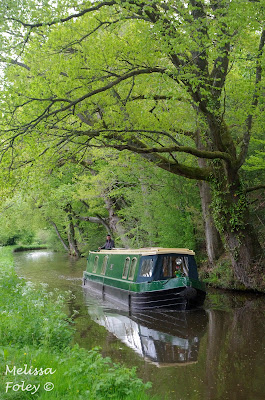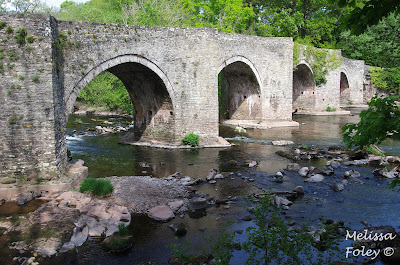We had a few days on either side of our narrowboat adventure to explore northern Wales and a bit of England. Our first stop was in Oxford, England, a couple hours north of London. Other than enjoying the architecture and history of the city, we didn't have anything planned for our two days there. Getting there was an adventure in itself. After realizing that train travel in the UK is not the economical option like it is on the continent, we picked up a one-way rental car in London. Pete braved the London traffic and narrow Oxfordshire roads while I tried to navigate us through the sometimes incredibly confusing stacks of roundabouts. Our B&B in Oxford was a bit outside the city centre and well situated for evening strolls along the River Thames and to all the main Oxford attractions.
As we wandered around the town marveling at the loveliness of the buildings and spring gardens, Pete was picking up pieces of passing conversations about an event happening the next morning. After a bit of internet searching, we realized people planning for May Morning, the annual May Day celebration in Oxford, which was taking place the next day. May Morning celebrations were cancelled the previous two years because of covid and May 1st was a Sunday that coincided with a long bank holiday weekend, so the crowd was expected to be quite large. We were not quite sure what we were getting ourselves into, but we woke at 5 am and joined the gathering stream of pedestrians heading toward Magdalen Bridge. We found a spot on the edge of the gathering crowd (estimated to be over 12,500 people) where we had a relatively good view of Magdalen Tower. The Magdalen College Choir stands atop the tower and sings a hymn promptly at 6 am, a tradition going back over 500 years. As the bells tolled at 6 am, the susurrus of the crowd immediately stopped. It was silent when the choir sang the first note. It was incredible. Everyone stood in silent awe as the voices rang out from the tower. After a prayer for "town" and "gown" (Oxford City and Oxford College) and another selection from the choir, the bells began to peal as the crowd processed up High Street where Morris dancers and musicians of all types carried on the festivities. We watched the merriment for a bit and then walked back to our B&B for a short nap before heading north to visit friends.
After our week on the narrowboat, we headed to northern Wales. Our first stop was Llangollen, where we stayed at an amazing hotel situated between the River Dee and the head of the Llangollen branch of the Shropshire and Union Canal. Because we were no longer cooking most of our meals, I had to be on the lookout for places that could cater to my gluten- and dairy-free dietary needs. One of the traditional English foods that I knew would be difficult for me to find was fish and chips. During a bit of pre-trip sleuthing, I found a place in Llangollen that came highly recommended from the gluten-free crowd and fish and chips were on the menu. The setting and the food were delightful!
took over much of the goods transport so the railway bridge
We next stationed ourselves in the bustling town of Betws-y-Coed on the edge of Snowdonia National Park for a couple of days. From there we explored two of the many castles dotted around Northern Wales from the days of King Edward I (late 1200s). The heavily fortified castles in Conwy and Caernarfon, two of the four included in the World Heritage listing for their military architecture, are still quite intact, featuring my favorite medieval defenses - barbicans and murder holes. The two castles were also naturally defended on two sides by their respective rivers and estuaries. While strategic, these also made for beautiful settings with views of water and the surrounding hills from every vantage point. The town walls are also still largely intact, particularly in Conwy, which were fun to explore. Caernarfon was the only one of the castles properly lived in by King Edward I's family. The other three were still being completed when they were besieged by the Welsh during the early 1300s. Caernarfon was also seized but was taken back by the royal family in the 1600s and eventually taken over by the government for maintenance and repairs. In recent times, the castle has the site for the investiture of the Prince of Wales in 1911 for Prince Edward VIII and 1969 for Prince Charles.
feature not seen in most defunct castles
(or at least a knight)
We also managed a few hikes while we were in the north. There are many trails around Betws-y-Coed in Gwydir forest, which were great for a morning run or late afternoon ramble, even if they are steep. In one section of the forest, there were dedicated mountain bike routes. As a runner, I loved this idea. There have been may times where I have nearly been run over by mountain bikes racing down a hill that are not expecting to encounter me coming around a corner. Between Caernarfon and Betws-y-Coed, we hiked around Llyn Idwal, a beautiful glacial lake at the base of a hanging valley. It was our only up close glimpse of the beauty of Snowdonia and the slate landscape that dominates the western side of the park. The slate was put to good use on the Llyn Idwal walking path, with giant slabs used to make small bridges across streams.
Our final day in northern Wales was spent riding the oldest narrow gauge steam train in the world from Porthmadog to Tan-y-Bwlch. I had hoped to get tickets on the train that went all the way to Blaenau Ffestiniog, one of the centers of slate mining, but the trip was sold out. Our drive from Betws-y-Coed, however, took us through Blaenau Ffestiniog, so we got to see the slate quarry and hillsides rising above the town anyway. Porthmadog is a lovely coastal town next to the edge of the estuary, with the hills of Snowdonia rising to the northeast. Our coal-fed steam train chugged up the hill through woodlands and small villages for about an hour before we disembarked at Tan-y-Bwlch. We had about 45 minutes there before the return trip, so we walked down to Llyn Mair, keeping our eyes out for otters (no such luck). The steam engine was quite lovely and a fair bit smaller than the ones operating on the narrow gauge tracks a couple miles from our house. The rail line was originally built to move slate from the quarries around Blaenau Ffestiniog to ships in Porthmadog. The line was graded such that the journey from the quarries to the port was all downhill because horses were originally used to pull the carts. There were some very narrow sections where cuts in the hillsides were made just wide enough for the carts to pass through. Steam engines replaced the horses in the mid-1800s as production at the quarries continued to increase. The standard gauge railway eventually surpassed the narrow gauge in transporting slate; the narrow gauge tracks have predominantly been used for tourism since the 1950s.
Wales and her people were lovely. I look forward to returning and getting a different take of the country than the very colonist-centric view we got this time. While the Scottish get most of the props today for their views on independence from England and the crown, the Welsh also have a long history of fighting for independence and a unique culture that is quite different from the rest of the countries in the UK. While in the States we only need to look back a few hundred years to delve into the history of our traditional people and cultures, it requires a much, much longer trip to the past (3500 BC) to understand the history and the many shifts in culture that have occurred on that small island in the North Atlantic.
On our way back to London, we decided on a route that took us through Bath, England, to see the Roman Baths. We stayed outside the city proper at a guest house and pub that turned out to be perfectly situated for catching the bus into Bath. Navigating the narrow streets and parking situation were not high on our list of travel goals!
The baths were built in the 1st century AD by the Romans using the natural thermal properties of the area to create a spa and temple. The city of Bath is centered around the old city of Aquae Sulis, which has been largely preserved. The hot water stills flows into the largest bath as it did 2000 years ago. Kind of spectacular! The Georgian architecture found all over the city, which was a much later addition in the 1700s, is beautiful and much more reminiscent of cities in Europe than the UK. We had a nice time exploring the baths and the city. This last stop brought our World Heritage site count for the trip to seven. Besides the Roman baths, most were focused around the country's industrial landscape (coal, slate, iron). While interesting to see, those sites have a bit less appeal for me than the sites of culture or natural significance we usually visit.
the world that has shops built into the bridge on both sides
Our drive back to London was uneventful and we passed our covid tests so were allowed to travel home. That hurdle had given me some anxiety during our travels, particularly in our last week when we were around more people than we were on the narrowboat. Fortunately for us, the omicron wave had gone through the UK before we arrived and the BA.5 variant had yet to arrive. Yet another international trip where we managed to get in and out just in time...


